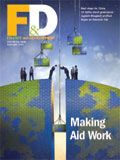 About F&D Subscribe Back Issues Write Us Copyright Information Free Email Notification Receive emails when we post new
items of interest to you. |
Official development assistance (ODA) to developing countries increased steadily during the 1970s and 1980s. The end of the Cold War led to a significant decline in global ODA over the first half of the 1990s, after which it returned to its pre-1991 upward trend. Recent Group of Eight commitments to double aid to Africa suggest that this upward trend will continue. While almost three-fourths of ODA during 1970–2003 was provided through bilateral programs, the proportion channeled through multilateral organizations has increased since the 1980s. Private aid has displayed a more steady trend, growing slowly over the past three decades to around 11 percent, although the official data are almost certainly understated.
Nearly two-thirds of ODA goes to least developed and low-income countries (those with a 2004 gross national income (GNI) per capita of less than $825). Another third goes to lower middle-income countries such as Algeria, Brazil, China, and Thailand (those with a GNI per capita of less than $3,255), whose populations contain substantial numbers of poor people. About 3 percent is allocated to upper middle-income countries such as Argentina and Chile. Over a third of world aid goes to sub-Saharan Africa, but in per capita terms, this still amounted to less than $35 per African in 2003.
Larger countries tend to receive more aid, but smaller amounts of aid
per capita. India and China are among the top aid recipients, but are
The major bilateral donors, coordinated through the OECD's Development Assistance Committee (DAC), comprise the United States, Japan, and Western Europe. France, Germany, and Japan have reduced their contributions in recent years, while the Scandinavian countries, the United Kingdom and, more recently, the United States have increased theirs. Denmark, Norway, the Netherlands, Sweden, and Luxembourg contribute well above the long-standing UN goal of 0.7 percent of GNI for development assistance. Italy, the United States, Greece, and Japan contribute the smallest shares of their GNI—all below 0.25 percent.
For most of the 1990s, around 40 percent of all aid went to the development of economic infrastructure and productive sectors (agriculture, industry, and trade). In recent years, greater emphasis has been given to social sectors (health, education, water supply/sanitation, and strengthening institutions and civil society). Social infrastructure and services accounted for almost one-third of aid in 2003, up from 20 percent in 1990.
Aid has been associated with high growth in some countries, but not in others. Some recent studies find a positive relationship between aid and growth, and there is evidence that aid targeted at infrastructure, productive sectors, and budget and balance of payments support can help stimulate growth relatively quickly. Other research has found either no overall relationship, or a conditional relationship in which aid effectiveness depends on strong policies or institutions.
|